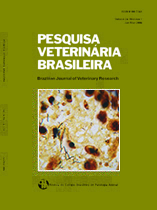 |
|
|
|
Year 2016 - Volume 36, Number 8
|

|
Insulin binding characteristics in canine muscle tissue: effects of the estrous cycle phases, 36(8):761-766
|
ABSTRACT.- Pöppl A.G., Valle S.C., González F.H.D., Kucharski L.C. & Da Silva R.S.M. 2016. Insulin binding characteristics in canine muscle tissue: effects of the estrous cycle phases. Pesquisa Veterinária Brasileira 36(8):761-766. Setor de Clínica de Pequenos Animais, Hospital de Clínicas Veterinárias. Departamento de Medicina Animal, Faculdade de Veterinária, Universidade Federal do Rio Grande do Sul, Av. Bento Gonçalves 9090, Porto Alegre, RS 91540-000, Brazil. E-mail: alan.poppl@ufrgs.br
Hormonal fluctuations during the different estrous cycle are a well-recognized cause of insulin resistance in bitches, and little is known about insulin receptor binding or post-binding defects associated with insulin resistance in dogs. To evaluate insulin binding characteristics in muscle tissue of bitches during the estrous cycle, 17 owned bitches were used in the study (six in anestrus, five in estrus, and six in diestrus). An intravenous glucose tolerance test (IVGTT) was performed in all patients by means of injection of 1mL/kg of a glucose 50% solution (500mg/kg), with blood sample collection for glucose determination at 0, 3, 5, 7, 15, 30, 45 and 60 minutes after glucose infusion. Muscle samples, taken after spaying surgery, were immediately frozen in liquid nitrogen and then stored at -80 ºC until the membranes were prepared by sequential centrifugation after being homogenized. For binding studies, membranes were incubated in the presence of 20,000cpm of human 125I-insulin and in increasing concentrations of unlabeled human regular insulin for cold saturation. The IVGTT showed no differences among bitches during the estrous cycle regarding baseline glycemia or glycemic response after glucose infusion. Two insulin binding sites - high-affinity and low-affinity ones - were detected by Scatchard analysis, and significant statistical differences were observed in the dissociation constant (Kd1) and maximum binding capacity (Bmax1) of the high-affinity binding sites. The Kd1 for the anestrus group (6.54±2.77nM/mg of protein) was smaller (P<0.001) than for the estrus (28.54±6.94nM/mg of protein) and diestrus (15.56±3.88nM/mg of protein) groups. Bmax1 in the estrus (0.83±0.42nM/mg of protein) and diestrus (1.24±0.24nM/mg of protein) groups were also higher (P<0.001) than the values observed in anestrus (0.35±0.06nM/mg of protein). These results indicate modulation of insulin binding characteristics during different phases of the estrous cycle in dogs, showing that muscle insulin binding affinity for its receptor is reduced during estrus and diestrus. However, this poor hormone-receptor affinity is compensated for by a greater total binding capacity, once there is no difference in patients’ glycemic response after an intravenous glucose load. |
| |
|
|
| |
|
 |